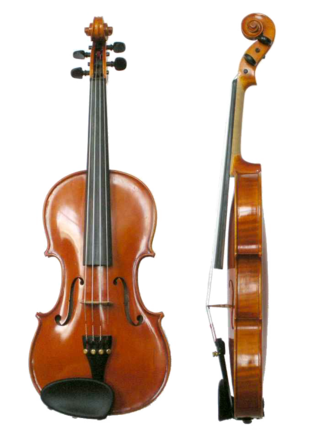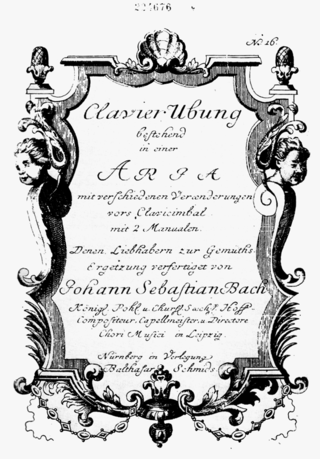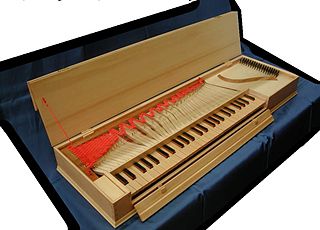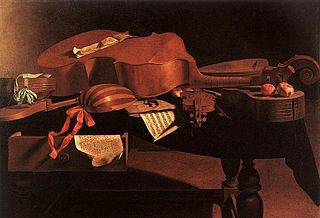Related Research Articles

Figured bass is musical notation in which numerals and symbols appear above or below a bass note. The numerals and symbols indicate intervals, chords, and non-chord tones that a musician playing piano, harpsichord, organ, or lute should play in relation to the bass note. Figured bass is closely associated with basso continuo: a historically improvised accompaniment used in almost all genres of music in the Baroque period of Classical music, though rarely in modern music. Figured bass is also known as thoroughbass.
In music, a glissando is a glide from one pitch to another. It is an Italianized musical term derived from the French glisser, "to glide". In some contexts, it is equivalent to portamento, which is a continuous, seamless glide between notes. In other contexts, it refers to discrete, stepped glides across notes, such as on a piano. Some terms that are similar or equivalent in some contexts are slide, sweepbend, smear, rip, lip, plop, or falling hail. On wind instruments, a scoop is a glissando ascending to the onset of a note achieved entirely with the embouchure, except on instruments that have a slide.

The violin, colloquially known as a fiddle, is a wooden chordophone, and is the smallest, and thus highest-pitched instrument (soprano) in regular use in the violin family. Smaller violin-type instruments exist, including the violino piccolo and the pochette, but these are virtually unused. Most violins have a hollow wooden body, and commonly have four strings, usually tuned in perfect fifths with notes G3, D4, A4, E5, and are most commonly played by drawing a bow across the strings. The violin can also be played by plucking the strings with the fingers (pizzicato) and, in specialized cases, by striking the strings with the wooden side of the bow.
Vibrato is a musical effect consisting of a regular, pulsating change of pitch. It is used to add expression to vocal and instrumental music. Vibrato is typically characterized in terms of two factors: the amount of pitch variation and the speed with which the pitch is varied.
In music, tremolo, or tremolando, is a trembling effect. There are multiple types of tremolo: a rapid repetition of a note, an alternation between two different notes, or a variation in volume.

The Goldberg Variations, BWV 988, is a musical composition for keyboard by Johann Sebastian Bach, consisting of an aria and a set of 30 variations. First published in 1741, it is named after Johann Gottlieb Goldberg, who may also have been the first performer of the work.
In music, ornaments or embellishments are musical flourishes—typically, added notes—that are not essential to carry the overall line of the melody, but serve instead to decorate or "ornament" that line, provide added interest and variety, and give the performer the opportunity to add expressiveness to a song or piece. Many ornaments are performed as "fast notes" around a central, main note.
The trill is a musical ornament consisting of a rapid alternation between two adjacent notes, usually a semitone or tone apart, which can be identified with the context of the trill. It is sometimes referred to by the German Triller, the Italian trillo, the French trille or the Spanish trino. A cadential trill is a trill associated with each cadence. A trill provides rhythmic interest, melodic interest, and—through dissonance—harmonic interest. Sometimes it is expected that the trill will end with a turn, or some other variation. Such variations are often marked with a few appoggiaturas following the note bearing the trill indication.

Bebung is a type of vibrato executed on the clavichord.
A grace note is a kind of music notation denoting several kinds of musical ornaments. It is usually printed smaller to indicate that it is melodically and harmonically nonessential. When occurring by itself, a single grace note indicates either an acciaccatura when notated with an oblique stroke through the stem, or an appoggiatura when notated without. When they occur in groups, grace notes can be interpreted to indicate any of several different classes of ornamentation, depending on interpretation. For percussion, such as drums, a related concept are ghost notes — supportive snare-hits at a lower volume.
An appoggiatura is a musical ornament that consists of an added non-chord note in a melody that is resolved to the regular note of the chord. By putting the non-chord tone on a strong beat, this accents the appoggiatura note, which also delays the appearance of the principal, expected chord note. The added non-chord note, or auxiliary note, is typically one degree higher or lower than the principal note, and may be chromatically altered. An appoggiatura may be added to a melody in a vocal song or in an instrumental work.
A nonchord tone (NCT), nonharmonic tone, or embellishing tone is a note in a piece of music or song that is not part of the implied or expressed chord set out by the harmonic framework. In contrast, a chord tone is a note that is a part of the functional chord . Non-chord tones are most often discussed in the context of the common practice period of classical music, but they can be used in the analysis of other types of tonal music as well, such as Western popular music.
A variety of musical terms are encountered in printed scores, music reviews, and program notes. Most of the terms are Italian, in accordance with the Italian origins of many European musical conventions. Sometimes, the special musical meanings of these phrases differ from the original or current Italian meanings. Most of the other terms are taken from French and German, indicated by Fr. and Ger., respectively.

Basso continuo parts, almost universal in the Baroque era (1600–1750), provided the harmonic structure of the music by supplying a bassline and a chord progression. The phrase is often shortened to continuo, and the instrumentalists playing the continuo part are called the continuo group.
The Western concert flute is a family of transverse (side-blown) woodwind instruments made of metal or wood. It is the most common variant of the flute. A musician who plays the flute is called a “flautist” in British English, a “flutist” in American English.

A Baroque violin is a violin set up in the manner of the baroque period of music. The term includes original instruments which have survived unmodified since the Baroque period, as well as later instruments adjusted to the baroque setup, and modern replicas. Baroque violins have become relatively common in recent decades thanks to historically informed performance, with violinists returning to older models of instrument to achieve an authentic sound.
Finger vibrato is vibrato produced on a string instrument by cyclic hand movements. Despite the name, normally the entire hand moves, and sometimes the entire upper arm. It can also refer to vibrato on some woodwind instruments, achieved by lowering one or more fingers over one of the uncovered holes in a trill-like manner. This flattens the note periodically creating the vibrato.
John Bennett was an English organist and composer.

The slide is a musical ornament often found in baroque musical works, but used during many different periods. It instructs the performer to begin two or three scale steps below the marked note and "slide" upward—that is, move stepwise diatonically between the initial and final notes. Though less frequently found, the slide can also be performed in a descending fashion.

Baroque music refers to the period or dominant style of Western classical music composed from about 1600 to 1750. The Baroque style followed the Renaissance period, and was followed in turn by the Classical period after a short transition. The Baroque period is divided into three major phases: early, middle, and late. Overlapping in time, they are conventionally dated from 1580 to 1650, from 1630 to 1700, and from 1680 to 1750. Baroque music forms a major portion of the "classical music" canon, and is widely studied, performed, and listened to. The term "baroque" comes from the Portuguese word barroco, meaning "misshapen pearl". The works of Antonio Vivaldi, George Frideric Handel and Johann Sebastian Bach are considered the pinnacle of the Baroque period. Other key composers of the Baroque era include Claudio Monteverdi, Domenico Scarlatti, Alessandro Scarlatti, Alessandro Stradella, Tomaso Albinoni, Johann Pachelbel, Henry Purcell, Georg Philipp Telemann, Jean-Baptiste Lully, Jean-Philippe Rameau, Marc-Antoine Charpentier, Arcangelo Corelli, François Couperin, Johann Hermann Schein, Heinrich Schütz, Samuel Scheidt, Dieterich Buxtehude, Gaspar Sanz, José de Nebra, Antonio Soler, Carlos Seixas and others.
References
If a full citation is not given, no author was given for the Grove article.
- Kreitner, Kenneth; Jambou, Louis; Hunter, Desmond; Carter, Stewart A.; Peterwalls; Ng, Kah-Ming; Schulenberg, David; Brown, Clive (2001). "Ornaments". In Sadie, Stanley; Tyrrell, John (eds.). The New Grove Dictionary of Music and Musicians (2nd ed.). London: Macmillan Publishers. ISBN 978-1-56159-239-5.
- Matthias Thiemel "Accent"
- "Accento"
- "Trill"
- G. Moens-Haenen, "Vibrato"